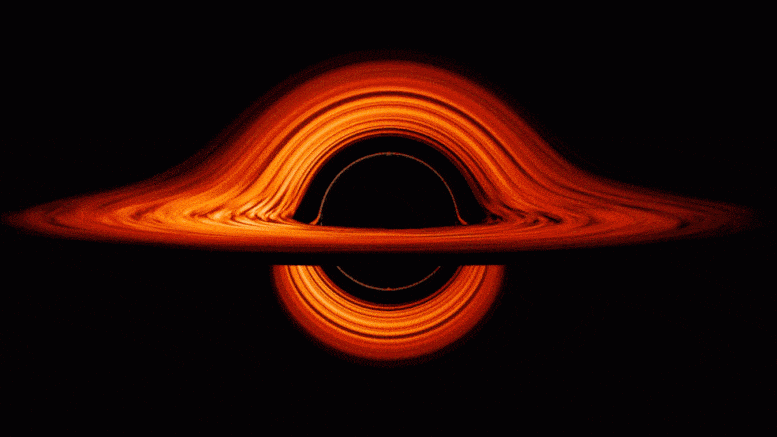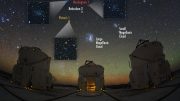
Seen nearly edgewise, the turbulent disk of gas churning around a black hole takes on a crazy double-humped appearance. Credit: NASA’s Goddard Space Flight Center/Jeremy Schnittman
A new Columbia study indicates energy can be extracted from black holes through reconnection of magnetic field lines.
A remarkable prediction of Einstein’s theory of general relativity—the theory that connects space, time, and gravity—is that rotating black holes have enormous amounts of energy available to be tapped.
For the last 50 years, scientists have tried to come up with methods to unleash this power. Nobel physicist Roger Penrose theorized that a particle disintegration could draw energy from a black hole; Stephen Hawking proposed that black holes could release energy through quantum mechanical emission; while Roger Blandford and Roman Znajek suggested electromagnetic torque as a main agent of energy extraction.
Now, in a study published in the journal Physical Review D, physicists Luca Comisso from Columbia University and Felipe Asenjo from Universidad Adolfo Ibáñez in Chile, found a new way to extract energy from black holes by breaking and rejoining magnetic field lines near the event horizon, the point from which nothing, not even light, can escape the black hole’s gravitational pull.
“Black holes are commonly surrounded by a hot ‘soup’ of plasma particles that carry a magnetic field,” said Luca Comisso, research scientist at Columbia University and first author on the study. “Our theory shows that when magnetic field lines disconnect and reconnect, in just the right way, they can accelerate plasma particles to negative energies and large amounts of black hole energy can be extracted.”
This finding could allow astronomers to better estimate the spin of black holes, drive black hole energy emissions, and might even provide a source of energy for the needs of an advanced civilization, Comisso said.
Why Reconnection Works
Comisso and Asenjo built their theory on the premise that reconnecting magnetic fields accelerate plasma particles in two different directions. One plasma flow is pushed against the black hole’s spin, while the other is propelled in the spin’s direction and can escape the clutches of the black hole, which releases power if the plasma swallowed by the black hole has negative energy.
“It is like a person could lose weight by eating candy with negative calories,” said Comisso, who explained that essentially a black hole loses energy by eating negative-energy particles. “This might sound weird,” he said, “but it can happen in a region called the ergosphere, where the spacetime continuum rotates so fast that every object spins in the same direction as the black hole.”
Inside the ergosphere, magnetic reconnection is so extreme that the plasma particles are accelerated to velocities approaching the speed of light.
Asenjo, professor of physics at the Universidad Adolfo Ibáñez and coauthor on the study, explained that the high relative velocity between captured and escaping plasma streams is what allows the proposed process to extract massive amounts of energy from the black hole.
“We calculated that the process of plasma energization can reach an efficiency of 150 percent, much higher than any power plant operating on Earth,” Asenjo said. “Achieving an efficiency greater than 100 percent is possible because black holes leak energy, which is given away for free to the plasma escaping from the black hole.”
An Energy Source for the Future?
The process of energy extraction envisioned by Comisso and Asenjo might be already operating in a large number of black holes. That may be what is driving black hole flares—powerful bursts of radiation that can be detected from Earth.
“Our increased knowledge of how magnetic reconnection occurs in the vicinity of the black hole might be crucial for guiding our interpretation of current and future telescope observations of black holes, such as the ones by the Event Horizon Telescope,” Asenjo said.
While it may sound like the stuff of science fiction, mining energy from black holes could be the answer to our future power needs.
“Thousands or millions of years from now, humanity might be able to survive around a black hole without harnessing energy from stars,” Comisso said. “It is essentially a technological problem. If we look at the physics, there is nothing that prevents it.”
The study, Magnetic reconnection as a mechanism for energy extraction from rotating black holes, was funded by the National Science Foundation’s Windows on the Universe initiative, NASA, and Chile’s National Fund for Scientific and Technological Development.
“The ideas and concepts discussed in this work are truly fascinating,” said Vyacheslav (Slava) Lukin, a program director at the National Science Foundation. NSF aims to catalyze new theoretical efforts based on frontier observations, he said, bringing together theoretical physics and observational astronomy under one roof.
“We look forward to the potential translation of seemingly esoteric studies of black hole astrophysics into the practical realm,” Lukin added.
Reference: “Magnetic reconnection as a mechanism for energy extraction from rotating black holes” by Luca Comisso and Felipe A. Asenjo, 13 January 2021, Physical Review D.
DOI: 10.1103/PhysRevD.103.023014









Perhaps unsaid here is this is the first instance of “negative energy” I’ve heard of through negative energy quantum particles. In a separate reference, Miguel Alcubierre postulated a design for a warp field engine allowing apparent faster than light travel but it required “negative energy” for which there is no known way to create. If making and breaking magnetic field lines can be shown to create true quantum particles of negative energy then to my knowledge this represents the first even plausible way to create such warp field, which is consistent with General Relativity, certainly a minimum requirement. This might be hopeful. I’m a retired physicist that just likes to contemplate far out possibilities.
… perhaps it would be a perfect recycle bin…